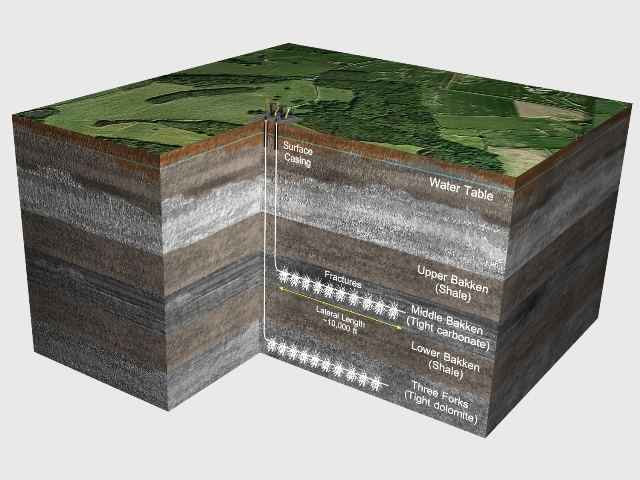It is important to understand in the case of the Weald basin, and many similar areas where some small scale conventional oil production has been happening for decades, that the companies involved (with the possible exception of Cuadrilla) usually have two simultaneous, but very different agendas. One is exploring for conventional oil and gas which will provide small returns but with a much higher chance of success. The other, is looking for unconventional oil and gas, which while a much riskier prospect, could produce massive returns for a small company. In the case of Horse Hill the conventional target is the Portland Sandstone and while this may be a big concern to people living near the Horse Hill well, it does not threaten to coat the Weald in wells. This small, local oil deposit could be drained by one or a small number of wells. In contrast the Kimmeridge Clay (and deeper Lias) shale formations covering a large part of the Weald are the unconventional target, which poses a vastly greater long term threat.

Aerial View Of Bakken Shale Tight Oil Extraction In McKenzie County, North Dakota (Click To Enlarge)
It has been obvious since before Cuadrilla drilled its well at Balcombe, that tight (shale) oil is the major target of unconventional exploration. Cuadrilla’s own Balcombe Environmental Method Statement for the Health and Safety Executive (HSE), clearly stated that they expected to encounter “tight oil” (often referred to as shale oil) in the formation they were targeting. This was in stark contrast to the smoke and mirrors produced by Cuadrilla’s PR machine. Tight oil, (sometimes referred to as Light Tight Oil), is an unconventional fossil fuel which is extracted from low permeability rocks via horizontal drilling and usually some sort of stimulation such as hydraulic fracturing or acid fracturing. No company has tried to extract tight oil before in the UK. Until the recent huge spike in energy prices it would not have been economic to do so.
At Balcombe, Cuadrilla was targeting oil trapped in a rock formation it referred to as “Micrite I” (sometimes called the Middle Kimmeridge Micrite 2) which is embedded within the Kimmeridge Clay, the shallower of the two major hydrocarbon bearing shale formations in the Weald Basin. Micrite is a carbonate rock composed of small mud like particles and typically has a quite low permeability. However, its permeability is likely be higher than the shale layers above and below it, hence the reason for targeting it. This situation is very similar to the Bakken Shale formation in North Dakota, from which the bulk of tight oil in the US has been extracted to date. The Middle Bakken, which has been the main target for extraction so far, is a low permeability layer of siltstone, dolomite and sandstone sandwiched between the Upper and Lower Bakken shale layers.

Kimmeridge Clay Shale Formation Is Similar To The Bakken Shale In North Dakota Where 10,000 Wells Have Been Drilled So Far (Click To Enlarge)
At Horse Hill, the two main carbonate layers within the Kimmeridge Clay were flow tested. The Lower Kimmeridge Limestone (referred to by Cuadrilla as “Micrite J”) and the Upper Kimmeridge Limestone (“Micrite I”) which the Balcombe well targeted. UK Oil & Gas Investments (UKOG) claim to have flowed over 450 barrels per day from a 83 ft section of the Lower Kimmeridge Limestone and 900 barrels per day (PDF) from an 88-foot section of the Upper Kimmeridge Limestone. This was followed by very worrying phrases like “full speed ahead” and “commercial reality”. An additional 168 barrels per day has been flowed from the Portland Sandstone, but this is conventional oil which would require a tiny number of wells to extract and would not be subject to the extremely steep decline rates of tight oil.
It should be noted that UKOG are already talking about the Kimmeridge Clay shale itself, as well as the deeper Lias and Oxford Clay shale formations as a potential future target, in addition to the various carbonate layers within the shale. This sort of extraction would be more analogous to the Eagle Ford Shale in Texas, where the oil comes from the formation itself rather than from embedded tight carbonates like the Bakken. It’s not hard to imagine the nightmare scenario where the Weald was devastated with successive waves of fracking; firstly targeting the slightly more permeable limestone layers, but returning to exploit more difficult to extract resources when prices rose significantly higher.
See Fracking The Weald: The Growing Tight Oil Threat for more information.

